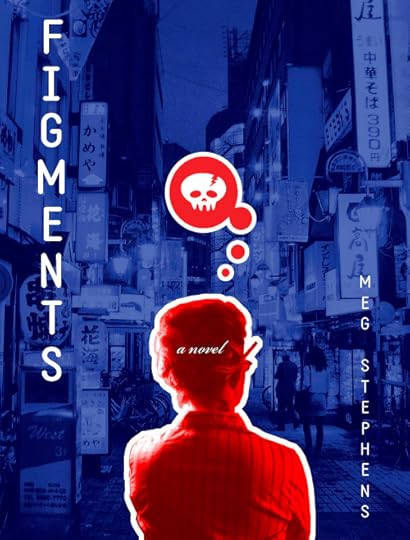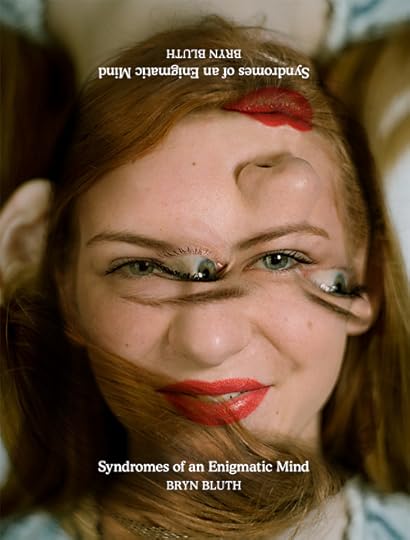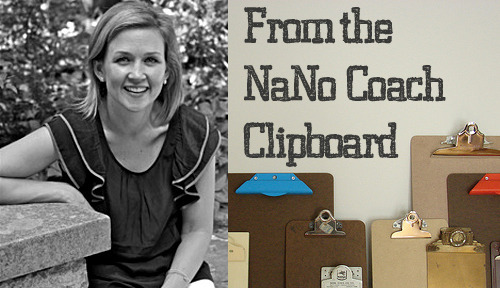Chris Baty's Blog, page 200
November 16, 2013
30 Covers, 30 Days: Day 16
Today’s cover was designed by Christine Mau, inspired by a NaNo-novel being written by Moira Richardson:

Big Foot T.V. by Moira Richardson
Reality TV just got extra real when a new contestant is thrown into the mix. Big Foot might be bigger, stronger, and hairier than the rest of competitors, but can he hang with this crowd of cut-throat would-be stars competing for the ultimate prize in reality television?
Watch as Big Foot falls in love, gets his heart broken, and learns about the human race during the show.
About the Designer
Christine Mau leads the European Design Team for Kimberly-Clark. She is passionate about packaging design and enjoys the print and pattern design development for the Kleenex® brand. Her first children’s book illustrations were recognized by the National Parenting Publication and the Wisconsin Library Association. Telegraphing a novel synopsis for the NaNo 30 Covers, 30 Days project was a challenge that she just couldn’t pass up. Christine currently lives in London with her BFF husband and teenage son, while their oldest son enjoys life as a CMU Design student.
November 15, 2013
Wrimos Around the World: Of Norway, Vikings, and Story Lego Pieces

One of the best parts of NaNoWriMo? The incredible community of writers. This week, we spotlight Atle Skarsten in Tananger, Norway:
Atle: Right now I’m writing you from a small town called Tananger, just west of Stavanger, the oil capital on the Norwegian west coast. Three of my distant relatives were some of the first to settle Tananger in the late 1600s. The place is packed with exciting history, most of it connected to maritime activities.
What is unique about where you are writing from?
Atle: I usually write from two different places: when I’m home in Tananger, I sit in my wood-fired sauna and write. I have built a small table in the sauna’s dressing room, just big enough for my computer, some reference books and my best friend—a cup of coffee. My mobile phone is left in the house and my wife never tells anyone where I am, not even the kids.
When I really need peace, quiet, and loads of inspiration to do my writing, I do as the Vikings did, and take my boat out west. Thirty minutes from our town lies the Saga island Rott, where we have a cabin/summer house. There is barely any reception, and I structure my days completely around writing, eating, and drinking coffee.
I make my own apple wine, strong, and store it in a huge oak barrel in the basement. When I need inspiration I go for a walk on this beautiful island… or look out the window… or just go down to the basement.
How would you describe your writing set-up in six words?
Atle: Cold sauna, stormy island, scenic view (… and a very strange mind).
Will you leave us with your best writing tips?
Atle:Every story is like a toy made up of a bunch of Lego bricks. You need to put them together, one brick at the time—one word at the time, until you have your story. Once started, the story gets a life of it’s own, trust me—you’ll see.
Write down all your ideas, on paper, PC or mobile phone. The most important thing is to get started, just write and let the story lead you.
30 Covers, 30 Days: Day 15
Today’s cover was designed by Tony Pinto, inspired by a novel being written by participant Meg Stephens:

Figments by Meg Stephens
A young foreign woman fresh out of university moves to Tokyo with the promise of a journalism job at a modest gaijin newspaper. She is given the task of reporting local crimes in English for the city’s expatriate community.
Fast forward a year, and this woman has grown tired of reporting petty purse snatching and uneventful bar fights. Then one day in a local grocery store, she wonders: What if she creates these crimes herself?
About the Designer
Tony Pinto is a designer, educator, and fine artist living in Southern California. Tony teaches graphic design at several colleges, and also works with clients at Grace/Pinto Communication Design with his wife and business partner, Adrienne Grace. He’s also on the board of AIGA Orange County, and the father of two teenagers and two cats. Despite all that, he can usually be found on Facebook.
"Street in Ikebukoro" photo modified from one taken by James Nash (aka Cirrus).
November 14, 2013
"Position yourself to succeed by doing the other things in your life that rejuvenate you. You can..."
- Jeff VanderMeer, on maximizing your writing productivity.
30 Covers, 30 Days: Day 14
Today’s cover was designed by Seth Johnson for a synopsis written by YWP participant Bryn Bluth:

Syndromes of an Enigmatic Mind by Bryn Bluth
Olivia Wiggins lived in a world of color, far beyond imaginable for the common mind, a world where sound had colors and visuals all its own, every letter was seen as a different color of the light spectrum, and daydreams were a reality.
Her parents have always found her referencing Tuesdays to be yellow odd, and her friends find her to be spacey at times, but it is only when Olivia herself notices that everyone else seems to live in an atmosphere of complete mundanity and grayscale that she finds out she has Synesthesia, or “Union of the Senses.”
As people start to hear about “the girl who sees sound,” her world blows up with requests from unknown faces as to what their voice’s color is, what their names look like to her, and shallow rhetorical questions as to what drugs she’s on; there are no drugs, it’s just how her brain has always been. But now, Olivia realizes, she needs a way out of it.
About the Designer
Seth Johnson is a designer, strategist, educator, and organizational leader. His Minneapolis-based consultancy partners with teams and clients in a wide range of business categories to conceive and implement branding and communications solutions. Using a human-centered approach to simplify and clarify, he makes his clients’ voices heard, their messages understood, and their visions realized.
A past president of AIGA Minnesota, Seth also served as its treasurer and co-director of education and founded its mentor program. Through his volunteer work, he strives to help emerging designers bridge the gaps between education and professional practice. He speaks frequently at universities and design organizations around the nation, serves on the governing board of Art Buddies, and was a founding member of FEAST MPLS.
November 13, 2013
"You’ve worked through some hard times with your novel, and sometimes—you realize now—your..."
This is precisely where you must decide to stick things out. Don’t lose heart: you will have those a-ha moments again. The romance can—and will—be rekindled. Stay true to your story.”
- Donna Freitas, on second-guessing your writing.
30 Covers, 30 Days: Day 13
Today’s cover was designed by José Nieto, and inspired by a synopsis by participant Benji Z.:

Neon Gods by Benji Z.
One day Samantha Whitfield blinked into existence. No one knows why, or where she came from, just that she appeared in the small town of St. Xavier, Montana one day and was hidden from the rest of the world.
Eighteen years later, she finds herself a normal person trying to make it in the world. Only, she’s stuck: not by some evil villain, not by some twist of fate, just stuck with life. She’s working a barely functional job at a game shop and her double life is starting to eat at her mind.
What double-life you might ask? Well, that she’s a superhero! One-half Buffy, one-half Scott Pilgrim, and cast into a neo-dystopian Miami landscape, Sam is left to save the world with everything she can while forces around her try to make sure the girl that came from nowhere returns there.
About the Designer
A native of San Juan, PR, José Nieto is Associate Creative Director at ARGUS in Boston. As a freelancer, he has worked for a variety of cultural clients, including Penguin, MassArt, the Institute of Contemporary Art, and the American Repertory Theatre.
November 12, 2013
NaNo Coach: Lose Yourself In the Language

This season we’ve brought on published authors to serve as NaNo Coaches to help guide you to reaching 50,000 words. Our second week’s NaNo Coach, Kristyn Kusek Lewis, shares her words of wisdom below:
Six years ago, when a fellow writer friend suggested we do NaNoWriMo together, my response was along the lines of “You’ve lost your damn mind,” but not quite that polite.
I had just spent a year working on the draft of a novel that ultimately never worked, and I had conceded, finally, to lay the thing to rest in my file cabinet, where it remains. But my friend, wise soul that she is, knew that what I needed in that moment was to start working on something else. She was right, because if you’ve been at this a while, you know: The only way to feel better about your writing is to write some more.
And, so.
I had a thread of an idea, something I’d been knocking around for a while, and I went with it. That December, when I looked back at what I’d written, I did so mostly through my fingers. I had 50,000 words, yes, but it was far from a novel. There were extraneous characters, shaky subplots that dribbled off into nothing… it was, essentially, a highly protracted brainstorm. And yet, I was thrilled. I had the raw material for what would eventually become my debut novel.
My point is this: NaNoWriMo is not Novel-O-Matic. You don’t get to November 30 and, ta-da, a book! No, what I want you to glean from this month is what November gave me, which is the joy of writing for the sake of the exercise itself.
Take the pressure off. I hereby give you permission to wing it.
Make this experience simply about spilling words out onto the page. How you reach your 50K is up to you: Write the ending first. Abandon your outlines. Change course mid-scene. So the dialogue goes on for days? Good! It’s probably helping you get to know your characters. You’ve suddenly realized that your big tie-it-all-together scene is junk? Great! Better now than six drafts from now.
Writing a novel in a month is lunacy, so let yourself go a little crazy. Go to the page without any expectations. Lose yourself in the language. Have fun. Play. And in December, or later, when you look back at what you produced, you might just find that you have the makings for something wonderful. I wish you the very best of luck.
Kristyn Kusek Lewis is the author of How Lucky You Are (Grand Central), which was a Target Emerging Authors Pick. A former magazine editor, Lewis is an established magazine writer who has written for many national publications including the New York Times, O: The Oprah Magazine, Real Simple, Reader’s Digest, Glamour, and many more. Her next novel, a love story about two doctors, a tragic accident, and the power of forgiveness, is due out from Grand Central in early 2015. She lives in Chapel Hill, North Carolina with her family.
Top photo modified from one taken by hownowdesign.
30 Covers, 30 Days: Day 12
Today’s cover was designed by Maria Popova, inspired by a synopsis written by Young Writers Program participant C. R. Wright:

Whisper by C.R. Wright
Eighteen-year-old Cayden Cleveland is plagued by dreams he can’t remember or explain. He wakes up with dark bags painted under his eyes, cracked lips, and a wave of exhaustion pouring over him.
Until one day, he does remember.
His dreams are filled with a silent forest and a beautiful girl who sings of things he cannot put into words. With his parents gone out of the country for the summer, he only has his childhood best friend Amelia to turn to.
When his dreams start leaking into his real life—from warnings about terrible things to come, to spies sent by a faerie queen—he is forced to confront the fact that his dreams may not actually be just dreams, and that the people in them are not as they appear to be.
About the Designer
Maria Popova is the founder and editor of Brain Pickings , an inventory of cross-disciplinary interestingness spanning art, science, design, history, philosophy, and more. Shehas written for WiredUK, The Atlantic,Nieman Journalism Lab, The New York Times, Smithsonian Magazine, and Design Observer, among others, and is an MIT Futures of Entertainment Fellow. She is on Twitter as @brainpicker.
November 11, 2013
Five Tips for NaNoWriMo: Week Two

NaNoWriMo’s Director of Programs, Chris Angotti, brings you five tips to survive Week Two:
For my advice this week, I decided to journey into the deep, dark NaNoWriMo pep talk archives to find a few hints from authors I admire. After pushing aside cobwebs, evading rat kings, and wondering what exactly that weird sludge is, I emerged with five fine-quality ideas. (Tim, our editorial director, later pointed out that all these pep talks are conveniently available on a sludge-free web page, a fact I certainly wish he’d told me earlier. I hope the rat kings get him.)
Chloroform your inner editor.
Pursue the anthills.
Write by hand.
Do the Raymond Chandler.
Print your pages.
Let’s venture deeper:
NUMBER ONE: Chloroform your inner editor.
I don’t know if Karen Russell knew about our Inner Editor concept before writing her pep talk, but she certainly brings him to life in the form of derisive, foul-mouthed coach. What to do with him?
“In order to write your novel, you must get rid of this sadist. Do whatever it takes to shut him up. Chloroform him; drag him by his white Reeboks behind the dugout; bury his shrill, censorious whistle. Then return to your green, blank, mercifully silent playing field, and write.”
Don’t give him the sick satisfaction of an unfinished novel.
NUMBER TWO: Pursue the anthills.
This is my all-time favorite piece of NaNo advice, as shared by Aimee Bender. If you’re supposed to be writing about cereal boxes, but you really feel like writing about an anthill… Write about the anthill. She tells us,
“That anthill might be a clue, a little signal from the unconscious, like a finger pointing to a rock, which is saying, ‘Look! Pick me up! Look under me! Try me out! There’s stuff here!’”
I take a lot of tangents in my novels—some of which pay off, but all of which make me laugh. Yesterday, a scene in a library somehow became an extended aside about Hobo Quidditch (they ride bindles). It took my story nowhere, but I had fun writing it. See where the anthills lead you.
NUMBER THREE: Write by hand.
If you can’t bear the idea of showing up at your computer for another day, try picking up a pen. It might even change your storytelling. As Lynda Barry says,
“There is a kind of story that comes from hand-writing which is different from a tapping-on-a-keyboard-kind-of-story. For one thing, there is no delete button, making the experience more life-like right away. You can’t delete the things you feel unsure about and because of this, the things you feel unsure about have a much better chance of being able to exist long enough to reveal themselves.”
Remember that most of us learned to write stories by hand. Tap back into your early, brave narratives and try it again. (Also, there are never enough power outlets at the coffee shop anyway.)
NUMBER FOUR: Do the Raymond Chandler.
No, this isn’t some weird dance; it’s a great tip for fast-tracking your story. If you don’t know what’s going to happen next, try Jonathan Lethem’s reminder:
“Raymond Chandler said that when he was at a loss for a plot development he’d have a man walk through a doorway with a gun in his hand.”
It’s not always a gun, it’s not always a man, but it’s always something unexpected. Can a dragon suddenly show up and terrorize your townspeople? Is it time for a surprise meet-cute in your rom-com? Bring in something out of nowhere.
NUMBER FIVE: Print your pages.
It’s possible that Kevin Wilson has Hewlett-Packard stock, but I still think this is an interesting idea: get your in-progress novel on paper.
“As the month progresses, as you print out another day’s worth of writing and add it to the stack of pages, embrace the sheer delight of seeing the world of your making assemble itself before you. The story within those pages will hold the real power, but don’t underestimate the weight of the physical object.”
Cool, right? A Word doc is just bits and bytes with no physical weight. But with a pile of actual pages—full of your ideas—you can see, feel, and weigh how your work is piling up.
— Chris Angotti, director of programs
Chris Baty's Blog
- Chris Baty's profile
- 63 followers



